2. 合肥工业大学资源与环境工程学院, 合肥 230009
2. School of Resources and Environmental Engineering, Hefei University of Technology, Hefei 230009, China
华北克拉通位于北部的中亚造山带和南部的秦岭-苏鲁-大别造山带之间,是我国最大和最古老的克拉通。华北克拉通形成于太古宙-古元古代,并在显生宙白垩纪时期经历了强烈破坏,其地质演化一直是国内外地质学界的研究热点 (Zhao et al., 2001; Zhai et al., 2002; Kusky et al., 2007a, b; Kusky, 2011; Zhai and Santosh, 2011; Zhao and Cawood, 2012; Zhao and Guo, 2012; Zheng et al., 2013)。虽然有学者认为华北不同陆块之间的拼贴在太古宙即已完成 (Kusky et al., 2001; Kusky and Li, 2003),但不断积累的大量高精度年代学数据表明,华北克拉通形成过程中的地体拼贴主要发生于古元古代 (Zhao et al., 2012)。
近十年来,有关华北克拉通最重要的研究成果就是在其中识别出三条古元古代造山带 (图 1a):中部造山带将华北克拉通分为东部陆块和西部陆块,胶辽吉带将东部陆块进一步划分为龙岗陆块和狼林陆块,孔兹岩带将西部陆块进一步分为阴山陆块和鄂尔多斯陆块 (Zhao et al., 2005; Zhao and Zhai, 2013)。国内外学者已对中部造山带和孔兹岩带进行了大量研究 (Kröner et al., 2005; Faure et al., 2007; Wang, 2009; Li et al., 2010; Santosh, 2010; Santosh et al., 2012; Trap et al., 2012; Zhang et al., 2012)。而相比之下,作为我国古元古代岩石出露较为完整的胶辽吉带则研究相对滞后,对于其中产出的具有条带状、片麻状特征的被称为条痕状花岗岩 (辽吉花岗岩) 的古元古代二长花岗片麻岩 (张秋生, 1988),学术界对其来源、成因、类型及构造环境等一直争论不休。关于条痕状花岗岩的来源及类型,刘光启 (1989)将该花岗岩识别为层状混合岩,认为其不是岩浆型的,而是重熔岩浆型的,原岩是沉积变质岩,赵凤顺和胡平 (1989)以及曲洪祥等 (2000)认为该花岗岩以火山-沉积岩重熔型的S型花岗岩为主。路孝平等 (2004b)以及郝德峰等 (2004)认为该花岗岩为A型花岗岩,杨明春等 (2015a)则认为该花岗岩属于I型花岗岩。在成因和构造环境方面,条痕状花岗岩最初被认为形成于元古宙早期的一种特殊的优地槽-坳拉槽环境中 (张秋生和李守义, 1985; Sun et al., 1993)。刘永江和李三忠 (1996)、陈树良等 (2000)以及郝德峰等 (2004)认为该花岗岩形成于裂谷环境中;刘俊来等 (2002)认为其形成于褶皱带早期阶段演化的伸展作用过程中;路孝平等 (2004b)认为条痕状花岗岩是辽吉地区古元古代地层沉积的基底岩石, 是地层沉积之前地壳拉张作用的结果, 属于一种非造山型花岗岩;杨明春等 (2015a)认为该花岗岩形成于下地壳来源的酸性岩浆和富集地幔来源的基性岩浆的混合,属于钙碱性弧岩浆。
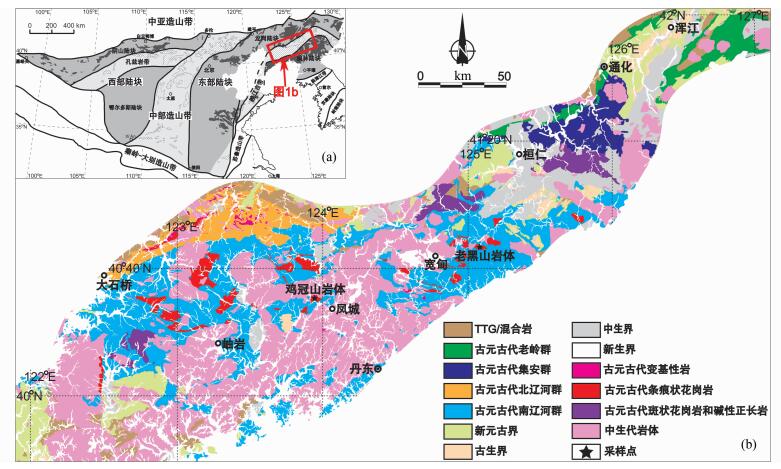
|
图 1 华北克拉通构造划分图 (a, 据Zhao et al., 2005) 和辽吉地区地质简图 (b, 据辽宁省地质矿产局, 1989; Wu et al., 2005修改) Fig. 1 Tectonic subdivision of the North China Craton (a, modified after Zhao et al., 2005) and geological sketch map of the Liaoji Belt (b, modified after BGMRL, 1989; Wu et al., 2005) |
花岗质岩石是早期地壳演化的重要记录者,花岗岩中蕴含着有关大陆形成与演化的丰富信息,上述有关条痕状花岗岩 (二长花岗片麻岩) 的争议严重制约了对区域构造演化的深入认识。作为辽吉带内的主要组成岩石之一,古元古代条痕状花岗岩经历了辽吉带形成与演化的整个过程,并在持续的地质演化过程中经历了强烈变形而形成明显的片麻状构造。因此,对该花岗岩进行岩石学、地球化学和成因学研究,可以解决上述争议,还原辽吉地区古元古代地质演化的整个过程,并进一步深入探讨华北克拉通早前寒武纪构造样式。鉴于此,本文选择胶辽吉带主要地质要素之一的条痕状花岗岩,对其进行详细的岩石学、地球化学和成因学研究,以期进一步深入探讨胶辽吉带北部辽吉地区的早前寒武纪地质演化。
2 地质背景和样品胶辽吉带呈北东-南西向展布于华北克拉通东部,介于龙岗陆块和狼林陆块之间,其展布范围包括北部的辽吉地区 (辽吉带) 和南部的胶北地区 (胶北地体),辽东在古元古代地质构造划分上即属于辽吉地区。辽吉地区古元古代岩石组合主要包括变质火山-沉积岩、花岗岩和镁铁质侵入体 (图 1b),其中变质火山-沉积岩被划分为北侧的老岭群和北辽河群以及南侧的集安群和南辽河群 (贺高品和叶慧文, 1998)。老岭群和北辽河群由透闪变粒岩、钠长浅粒岩、变质石英砂岩、硅质条带大理岩、白云石大理岩、十字石榴二云片岩和千枚岩等组成,原岩为陆源碎屑岩-碳酸盐岩建造 (路孝平等, 2005)。集安群和南辽河群由透辉变粒岩、蛇纹石化大理岩、斜长角闪岩、石墨大理岩、细粒黑云片麻岩、石榴夕线片麻岩等组成,原岩为火山岩-陆源碎屑岩-碳酸盐岩建造,以含有较多的变质火山岩区别于老岭群和北辽河群。近年来,随着分析测试技术的不断提高,不同学者获得了许多辽吉地区不同种类岩石的高精度U-Pb年代学资料。研究表明,上述辽吉带内火山-沉积岩形成于2.1~2.0Ga,并于1.9~1.88Ga发生变质作用 (Luo et al., 2004, 2008; Lu et al., 2006; Wan et al., 2006; 于介江等, 2007; 王惠初等, 2011; Xie et al., 2011; Meng et al., 2013a, 2014; 孟恩等, 2013; Li and Chen, 2014; 秦亚等, 2014; Hu et al., 2015; 李壮等, 2015; Li et al., 2015; 王惠初等, 2015)。
辽吉带内古元古代花岗质岩浆作用分为两期:条痕状花岗岩形成于2.2~2.1Ga (路孝平等, 2004b; Li and Zhao, 2007; 胡古月等, 2014; 杨明春等, 2015a),斑状花岗岩和碱性正长岩侵位于1.88~1.85Ga (蔡剑辉等, 2002; 路孝平等, 2004a, 2005; 杨进辉等, 2007; 杨明春等, 2015b)。条痕状花岗岩总是出现在辽河群或集安群的底部或是大型褶皱的核部 (路孝平等, 2004b),与周围古元古代火山-沉积岩呈构造接触 (图 2a),均经历了强烈的变形作用 (图 2b)。辽吉地区古元古代镁铁质侵入体亦分为2.1Ga和1.8Ga两期,但与火山-沉积岩和花岗岩相比出露较少,且多以岩墙岩脉形式产出 (Yuan et al., 2015)。
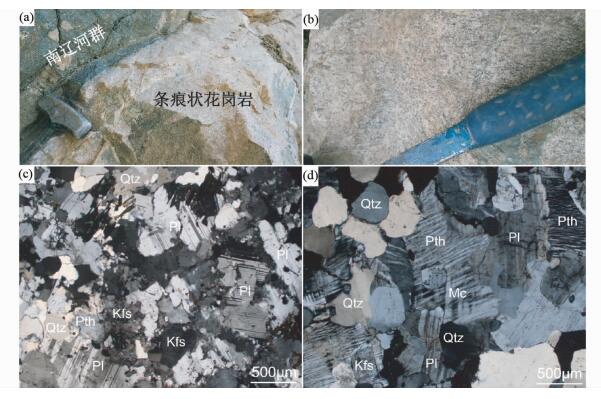
|
图 2 条痕状花岗岩野外照片与显微照片 Qtz-石英;Pl-斜长石;Kfs-钾长石;Pth-条纹长石;Mc-微斜长石 Fig. 2 Field photographs and photomicrographs of the monzogranitic gneisses Qtz-quartz; Pl-plagioclase; Kfs-potassium feldspar; Pth-perthite; Mc-microcline |
本文所研究的鸡冠山岩体和老黑山岩体均为胶辽吉带辽吉地区古元古代条痕状花岗岩,前人通过SHRIMP U-Pb锆石年代学研究获得两岩体年龄分别为2175±13Ma和2166±14Ma (Li and Zhao, 2007)。鸡冠山岩体呈浅肉红色,细粒花岗变晶结构,片麻状构造。主要矿物组成为石英 (35%)+斜长石 (15%~20%)+条纹长石 (15%~20%)+钾长石 (10%~15%)+磁铁矿 (3%)+角闪石 (1%~3%),副矿物主要有榍石和锆石。石英他形粒状,大都呈集合体排布,具有拉长和波状消光现象。斜长石呈短柱状,发育聚片双晶,有些已发生明显的弯曲变形 (图 2c),部分绢云母化黝帘石化。由于后期变形强烈,大部分矿物均有破碎。老黑山岩体呈粉灰色,中粗粒花岗变晶结构,片麻状构造。主要矿物组成为石英 (25%~30%)+条纹长石 (25%~30%)+斜长石 (10%~15%)+微斜长石 (5%~10%)+钾长石 (5%)+磁铁矿 (5%)+角闪石 (3%~5%),副矿物有锆石、榍石、独居石、褐帘石等。石英他形粒状,溶蚀长石形成港湾,有的被拉长形成断续的条带。斜长石具有明显的聚片双晶,微斜长石发育格子双晶 (图 2d)。角闪石呈黄绿色,不规则柱粒状,有的蚀变为黑云母和绿泥石。
3 分析方法全岩主量和微量元素分析在中国地质科学院国家地质实验测试中心完成。主量元素分析在3080E型荧光光谱仪 (XRF) 上进行,分析精度优于5%。微量元素在等离子质谱仪 (ICP-MS) 上测定,含量大于10×10-6的元素,分析误差为5%;含量小于10×10-6的元素,分析误差为10%。全岩Sm-Nd同位素的化学分离在北京大学造山带与地壳演化教育部重点实验室同位素分离超净实验室内完成,通过阳离子交换柱法分离和纯化。同位素测试在中国地质调查局天津地质调查中心同位素实验室利用Triton热电离质谱仪 (TIMS) 完成,Nd含量由同位素稀释法获得,分析误差小于0.5%。
4 分析结果样品的主量和微量元素分析结果见表 1。结果显示,辽吉地区鸡冠山岩体和老黑山岩体成分均匀,具有一致的地球化学特征。岩体主要成分包括SiO2(72.15%~74.52%)、Al2O3(12.26%~12.97%)、K2O (4.02%~5.75%)、Na2O (3.22%~4.03%)、Fe2O3(1.48%~2.04%)、FeO (1.06%~2.07%)、CaO (0.71%~1.99%)、TiO2(0.25%~0.33%)、MgO (0.12%~0.28%)、MnO (0.03%~0.06%) 和P2O5(0.02%~0.06%)。样品K2O/Na2O比值大于1(1.00%~1.73%),属于富钾质岩石,样品全碱 (K2O+Na2O) 含量变化于7.97%~9.08%。在SiO2-Na2O+K2O图中,辽吉条痕状花岗岩位于钙碱性花岗岩区域内 (图 3a),在SiO2-K2O图中,条痕状花岗岩主要位于高钾钙碱系列区域 (图 3b)。样品具有高的FeOT/(FeOT+MgO) 比值,绝大多数为含铁量较高的铁质花岗岩 (图 3c)。样品铝指数ASI (A/CNK=分子数Al2O3/(CaO+Na2O+K2O)) 介于0.84~1.03之间,A/NK值为1.11~1.17,在A/CNK-A/NK图解中落入准铝质和过铝质区域 (图 3d)。
|
|
表 1 条痕状花岗岩的主量元素 (wt%) 和微量元素 (×10-6) 分析结果 Table 1 Major (wt%) and trace (×10-6) element data for the monzogranitic gneisses |
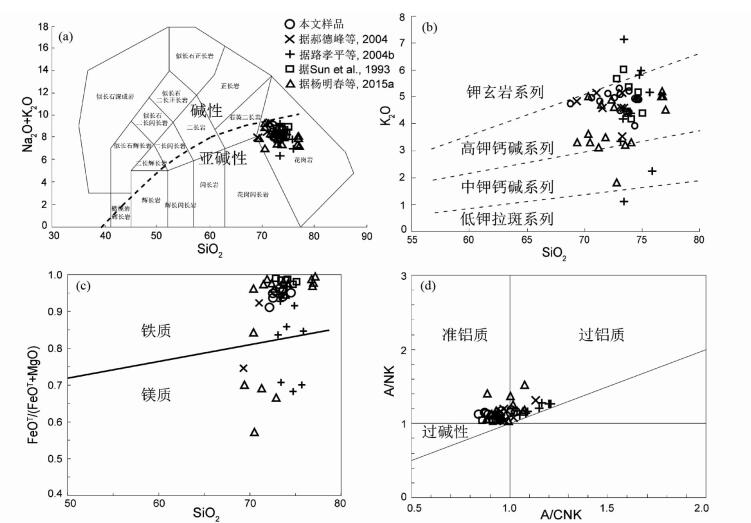
|
图 3 条痕状花岗岩的SiO2-Na2O+K2O (a, 据Middlemost, 1994)、K2O-SiO2(b, 据Peccerillo and Taylor, 1976)、SiO2-FeOT/(FeOT+MgO)(c, 据Frost et al., 2001) 和A/CNK-A/NK (d, 据Maniar and Piccoli, 1989) 图解 Fig. 3 SiO2 vs. Na2O+K2O (a, after Middlemost, 1994), K2O vs. SiO2 (b, after Peccerillo and Taylor, 1976), SiO2 vs. FeOT/(FeOT+MgO) (c, after Frost et al., 2001) and A/CNK vs. A/NK (d, after Maniar and Piccoli, 1989) diagrams for the monzogranitic gneisses |
样品稀土元素含量较高 (∑REE=202.7×10-6~668.9×10-6),轻重稀土分馏较为明显,其 (La/Sm)N=1.94~5.73,(La/Yb)N=4.80~20.6,具有弱的铕负异常。样品稀土配分曲线中,轻稀土元素富集,呈右倾模式,重稀土元素呈平坦分布模式 (图 4a)。微量元素特征显示样品具有高的Zr (256×10-6~384×10-6)、Th (5.94×10-6~42.40×10-6)、La (31.2×10-6~158.0×10-6)、Ce (72.8×10-6~297.0×10-6)、Y (43.2×10-6~54.8×10-6) 含量,非常低的Nb (14.0×10-6~22.2×10-6)、Ta (1.15×10-6~1.56×10-6)、Sr (71.8×10-6~104×10-6)、Sc (3.81×10-6~7.46×10-6)、Cr (0.89×10-6~2.21×10-6)、Co (0.66×10-6~1.54×10-6)、Ni (0.35×10-6~1.13×10-6) 含量。

|
图 4 条痕状花岗岩的球粒陨石标准化稀土元素配分图解 (a) 和原始地幔标准化微量元素蛛网图 (b)(标准化值据Sun and McDonough, 1989) Fig. 4 Chondrite-normalized REE patterns (a) and primitive mantle-normalized trace elements patterns (b) for the monzogranitic gneisses (normalizing values after Sun and McDonough, 1989) |
样品的Sm-Nd同位素分析结果见表 2。样品Sm含量为8.62×10-6~13.20×10-6,Nd含量为37.6×10-6~72.9×10-6,初始143Nd/144Nd变化于0.511226~0.511657之间,fSm/Nd变化于-0.44~-0.30之间。全岩Nd模式年龄根据DePaolo (1981)的计算方法计算获得,结果显示样品的εNd(t) 值为-3.3~-0.9,两阶段模式年龄tDM2=2860~2669Ma (岩体U-Pb年龄根据Li and Zhao, 2007)。
|
|
表 2 条痕状花岗岩的Nd同位素组成及计算参数 Table 2 Whole rock Nd isotopic composition and calculation parameters of the monzogranitic gneisses |
长期以来,许多关于辽吉地区地质演化的争论都来源于对花岗岩和周围火山-沉积岩之间关系的不同理解。以往的地质观察表明,条痕状花岗岩总是出现在辽河群或集安群等火山-沉积岩的底部或大型褶皱构造的核部,但局部又可见其见其侵入于上述火山-沉积岩之中,从而有花岗岩在元古宙“重就位”之说 (张秋生, 1988)。在野外,条痕状花岗岩同周围的火山-沉积岩呈明显的构造接触关系 (图 2a),表明两者是通过后来的构造作用混合拼贴在一起的,仅仅依据野外产状很难判断两者形成的先后顺序。所以,进一步明确花岗岩和火山-沉积岩的关系需要借助于两者的年代学研究。
虽然早期曾有学者认为火山-沉积岩的形成早于花岗岩侵位时间 (张秋生, 1988),但近年来高精度的SHRIMP和LA-ICP-MS锆石U-Pb年代学分析表明,这一结论是不成立的 (Luo et al., 2004; Li and Zhao, 2007; Li and Chen, 2014)。通过仔细观察可以发现,南、北辽河群、集安群和老岭群等火山-沉积岩可以进一步划分为火山岩组分和沉积岩组分,两者在成因来源方面明显不同。虽然沉积岩的沉积时限被限定在2.1~1.9Ga,但其中碎屑锆石年龄从晚太古代变化至古元古代,并具有~2.1Ga和~2.5Ga两个峰值 (Luo et al., 2008)。相比之下,火山岩组分的形成时代为2.2~2.1Ga,只有极少量的~2.5Ga的继承锆石年龄 (Lu et al., 2006; Li and Chen, 2014; Meng et al., 2014)。因此,2.2~2.1Ga侵位的条痕状花岗岩与火山-沉积岩中的火山岩组分是同时代的,但老于火山-沉积岩中沉积岩组分的沉积时限。换言之,花岗岩和上述火山岩组分代表古元古代岩浆活动,而火山-沉积岩中的沉积岩组分,一部分来源于古元古代岩浆岩的风化剥蚀,另一部分则来源于太古宙基底。
在讨论花岗岩与火山-沉积岩关系时必须要提及的是,南、北辽河群、集安群和老岭群等古元古代地层命名的客观性与真实性仍需要进一步探讨。长期以来,上述辽吉地区古元古代火山-沉积岩被当做地层来命名和处理,但近年来大量的年代学研究对上述地层的存在与命名提出了质疑。例如,就沉积时限而言,辽河群最底部的浪子山组比覆盖在其上的包括盖县组在内的辽河群其它地层均要年轻,并且群内各组一级地层的定年结果表现为全然无序,与原有自下而上各组地层时代逐渐变年轻的命名顺序完全无法对应并互为矛盾 (Luo et al., 2004; Wan et al., 2006)。因此,辽河群的原有沉积序列已被后期构造运动所强烈改造。
5.2 条痕状花岗岩成因类型及源区性质条痕状花岗岩具有低的CaO、MgO、Sc、Cr、Co、Ni、Sr、Eu含量,高的K2O/Na2O、FeOT/MgO、Ga/Al比值和Ga、Zr、Y含量等与A型花岗岩相一致的地球化学特征。条痕状花岗岩10000Ga/Al比值大于2.6,在Whalen et al. (1987)提出的判别图解中,绝大多数条痕状花岗岩都投影在A型花岗岩区域 (图 5)。Frost et al. (2001)进一步明确了铁含量在判别A型花岗岩中的作用,即在SiO2-FeOT/(FeOT+MgO) 图解中,位于铁质/镁质分界线之上及附近的花岗岩属于A型花岗岩。如图 3c所示,在SiO2-FeOT/(FeOT+MgO) 图中,除少数投影点分布在铁质/镁质分界线之下以外,绝大多数条痕状花岗岩均位于铁质/镁质分界线之上,即为A型花岗岩。本文样品以较高的Na2O (3.22%~4.03%) 和较低的P2O5含量 (0.02%~0.06%) 区别于高分异的S型花岗岩 (Na2O均值2.81%,P2O5均值0.02%),以高的形成温度 (813~867℃)、FeOT含量 (2.52%~3.55%) 和低的Rb含量 (106×10-6~171×10-6) 区别于高分异的I型花岗岩 (温度均值764℃,FeOT含量一般小于1.00%,Rb含量大于270×10-6)(King et al., 1997; 贾小辉等, 2009)。样品较高的Zr丰度 (256×10-6~384×10-6) 也是其区别于I型花岗岩的重要特征。
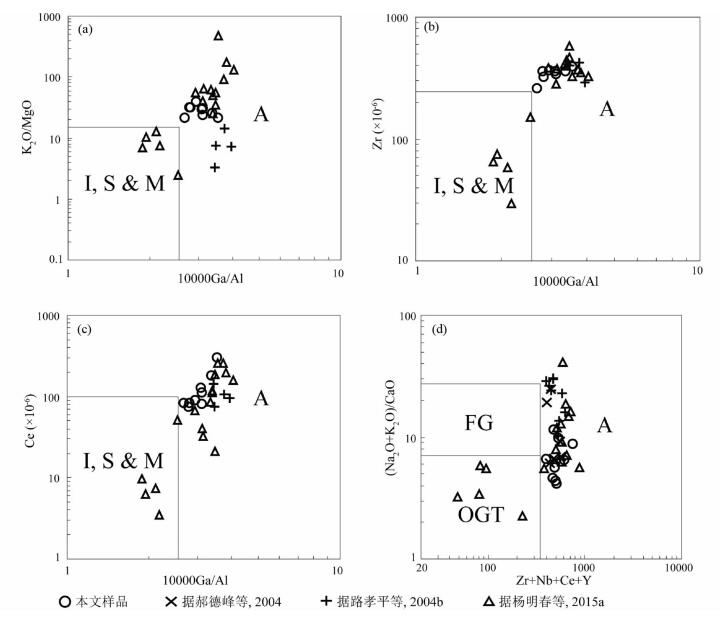
|
图 5 条痕状花岗岩成因类型判别 (据Whalen et al., 1987) Fig. 5 Genetic type discrimination of the monzogranitic gneisses (after Whalen et al., 1987) |
关于A型花岗岩的来源,一般认为其可以由地壳物质部分熔融形成,也可以是幔源碱性玄武质岩浆分离结晶作用的产物 (Loiselle and Wones, 1979; Eby, 1990; Frost et al., 2007; Dall’Agnol et al., 2012)。本文样品具有较高的SiO2(72.15%~74.52%) 和K2O (4.02%~5.75%),MgO (0.12%~0.28%)、Cr (0.89×10-6~2.21×10-6)、Ni (0.35×10-6~1.13×10-6) 含量极低,表明其为壳源岩浆。Collins et al. (1982)曾提出过熔融出花岗岩之后的残余长英质麻粒岩相下地壳作为A型花岗岩的源区,但这一模式被后来的岩石学实验所推翻:A型花岗岩最有可能源自英云闪长质-花岗闪长质地壳岩石15%~40%程度的部分熔融 (Creaser et al., 1991)。进一步的实验岩石学研究表明,铝质A型花岗岩形成于钙碱性花岗质岩石在低压 ( < 4kbar) 条件下的脱水部分熔融 (Patiño Douce, 1997)。辽吉条痕状花岗岩属于亚碱性花岗岩 (图 3a),在A/CNK-A/NK图解中落入准铝质和过铝质区域 (图 3d),是典型的铝质A型花岗岩,而不是碱性花岗岩。King et al. (1997)指出,铝质A型花岗岩和碱性A型花岗岩具有不同的地球化学特征及成因,碱性A型花岗岩是幔源碱性镁铁质岩浆分离结晶作用的产物,而铝质A型花岗岩则源于具有正常水含量的长英质地壳的部分熔融。澳大利亚拉克兰造山带内的铝质A型花岗岩即为长英质地壳在高温条件下部分熔融的产物 (King et al., 1997)。本文样品具有高的Yb (4.21×10-6~5.56×10-6)、Y (43.2×10-6~54.8×10-6) 含量,低的 (La/Yb)N和相对平坦的重稀土分布模式 (图 4a),反映其源自无石榴石残留相的熔融源区。Eu负异常和强烈亏损的Sr元素 (图 4b) 暗示条痕状花岗岩源区较浅 ( < 30km),处于斜长石稳定域内。辽吉条痕状花岗岩εNd(t) 值介于-8.63~+2.32(本文数据; 郝德峰等, 2004; 杨明春等, 2015a),tDM为2860~2669Ma (杨明春等, 2015a),大于岩石形成年龄,暗示条痕状花岗岩源区主要为太古宙基底,混有少量古元古代新生地壳 (图 6)。因此,条痕状花岗岩形成于低压条件下长英质太古宙地壳的脱水部分熔融。
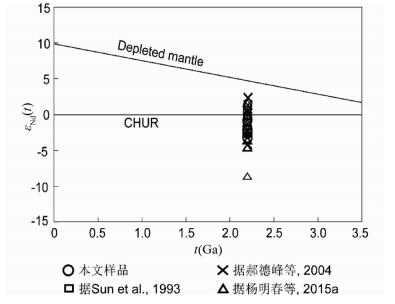
|
图 6 条痕状花岗岩的εNd-t图解 Fig. 6 Diagram of εNd vs. t for the monzogranitic gneisses |
King et al. (1997)在研究澳大利亚拉克兰造山带时明确指出,A型花岗岩可以形成于威尔逊旋回的各个阶段。在总结前人大量工作的基础上,Bonin(2007) 同样认为,A型花岗岩可以产于包括活动陆缘、被动陆缘、克拉通、裂谷等在内的各种构造环境中。本文样品富集Rb、U、K等大离子亲石元素和轻稀土元素,亏损Nb、Ta、Ti等高场强元素,具有明显的俯冲带岩浆特征 (Floyd and Winchester, 1975; Pearce, 1982; Briqueu et al., 1984)。条痕状花岗岩在Rb/30-Hf-Ta×3图中落入火山弧区域 (图 7a),在Y+Nb-Rb图解中落入火山弧花岗岩以及火山弧花岗岩和板内花岗岩之间的过渡区域 (图 7b)。Eby (1992)将A型花岗岩分为A1型和A2型两个亚类,A1型花岗岩具有与洋岛玄武岩相类似的地球化学特征,A2型花岗岩则具有明显的岛弧岩浆特征。在Y/Nb-Rb/Nb和Nb-Y-Ce图解中 (图 7c, d),辽吉条痕状花岗岩均落入A2型花岗岩区域,其Y相对于Nb更富集,具有与岛弧玄武岩相似的Y/Nb等元素比值,与辽吉带内同期变质基性岩一样,均显示俯冲成因 (王惠初等, 2011; Li and Chen, 2014; Meng et al., 2014; Yuan et al., 2015)。本文样品的Nb/Ta (11.34~14.88) 比值介于地壳Nb/Ta (11~12) 和地幔Nb/Ta (≈17.5) 之间,反映其源区受到了来自俯冲带交代地幔的流体的影响 (Green, 1995)。
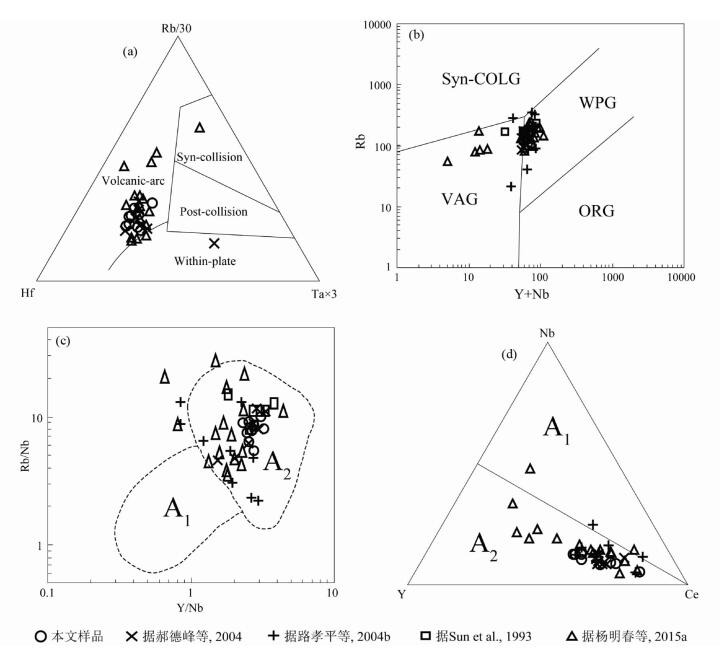
|
图 7 条痕状花岗岩的Rb-Hf-Ta (a, 据Harris et al., 1986)、Y+Nb-Rb (b, 据Pearce et al., 1984)、Y/Nb-Rb/Nb (c, 据Eby, 1992) 和Nb-Y-Ce (d, 据Eby, 1992) 判别图 VAG-火山弧花岗岩;syn-COLG-同碰撞花岗岩;WPG-板内花岗岩;ORG-洋中脊花岗岩 Fig. 7 Discriminations of Rb-Hf-Ta (a, after Harris et al., 1986), Y+Nb vs. Rb (b, after Pearce et al., 1984), Y/Nb vs. Rb/Nb (c, after Eby, 1992) and Nb-Y-Ce (d, after Eby, 1992) for the monzogranitic gneisses VAG-volcanic arc granitoids; syn-COLG-syn-collisional granitoids; WPG-within plate granitoids; ORG-ocean ridge granitoids |
关于辽吉地区古元古代构造演化的学术观点大致可以分为裂谷和岛弧两种。裂谷观点认为华北克拉通东部陆块在太古宙时为一整体,在古元古代早期经历了裂谷作用而形成洋盆,将东部陆块分裂为北部的龙岗陆块和南部的狼林陆块,其后伴随着洋盆的消减闭合,最终裂谷消失,龙岗陆块和狼林陆块又重新拼合 (陈荣度, 1984; 张秋生, 1984; 刘永江和李三忠, 1996; Luo et al., 2004; Li et al., 2005; Lan et al., 2015; Peng et al., 2016)。这一裂谷张开并闭合观点着重阐述的是,龙岗陆块和狼林陆块在太古宙时本来是一整体,正是由于古元古代的裂谷作用才产生了辽吉活动带,辽吉带的演化经历了一个从大陆拉张形成洋盆到大洋俯冲消减陆块重新拼合的完整的威尔逊旋回,裂谷作用是这一观点所强调的核心内容。而与裂谷张开并闭合观点相悖的是,另一些学者则认为龙岗陆块和狼林陆块之前并不在一起,两陆块无亲缘关系,只是由于大洋的消失才使得两陆块最终拼合在一起 (刘永达等, 1989; 白瑾等, 1993; Faure et al., 2004; Lu et al., 2006; Li and Chen, 2014; Meng et al., 2014)。这一观点强调俯冲作用在辽吉带形成过程中的重要作用及意义,并且龙岗陆块和狼林陆块在古元古代之前没有亲源性。
研究胶辽吉带古元古代构造演化时,首先必须要明确古元古代岩石的分布范围。长期以来,胶辽吉带以外的两侧区域分别被称为龙岗陆块和狼林陆块 (Zhao et al., 2005)。太古宙龙岗陆块早已被吉南和辽北地区出露的具有太古宙年龄的TTG片麻岩所确定 (Liu et al., 1992; Song et al., 1996; Wan et al., 2005, 2012; Wu et al., 2008, 2016; Grant et al., 2009; Guo et al., 2015; Zhu et al., 2015),但狼林陆块的命名及分布范围却值得怀疑 (图 1a)。狼林陆块的命名是依据出露于朝鲜的狼林群,但迄今为止,在狼林群中仍未发现具有确定太古宙年龄的TTG片麻岩,而且在狼林群中所获得的最老的年龄也只有1.9Ga,那些在野外看似TTG片麻岩的岩石实际上形成于古元古代晚期而并非太古宙 (Zhao et al., 2006)。换言之,临津江带以北的所谓的太古宙狼林群实际上是形成于古元古代晚期的岩石地层单位,胶辽吉带的真实展布范围比现在所认为的要大,狼林群很有可能也是胶辽吉带的一部分。事实上,在胶辽吉带以外的东南侧的辽东半岛地区,太古宙基底仅仅局限于最东南端的金州-庄河一带 (路孝平等, 2004a; Wu et al., 2005; Meng et al., 2013b)。但是在以往的研究中,由于缺乏高精度年代学的限定,太古宙基底的分布范围经常被过于夸大,而这一问题在地质学研究中是非常普遍的:许多岩石在野外看上去像是TTG片麻岩,但年代学研究表明它们形成于元古宙甚至显生宙。
胶辽吉带从朝鲜经中国东北延伸至山东半岛,在中国境内包括了北部的辽吉地区 (辽吉带) 和南部的胶北地区 (胶北地体)。然而,虽然胶北地区和辽吉地区同属胶辽吉带,但两地区的岩石构造组成却明显不同:胶北地体出露有大量的太古宙TTG片麻岩和夹杂于其中的新太古代-古元古代高压麻粒岩 (Zhou et al., 2004, 2008a, b; Tang et al., 2007; Tam et al., 2011, 2012a, b, c; Liu et al., 2012, 2013a, b, 2015; Wan et al., 2014; Wang et al., 2014; Wu et al., 2014a, b; Xie et al., 2014; Shan et al., 2015a, b; Zhao et al., 2015),并在此过程中发生了强烈的混合岩化作用 (Liu et al., 2014);而辽吉带则主要由古元古代火山-沉积岩和其中的侵入岩组成 (Luo et al., 2004, 2008; Lu et al., 2006; Wan et al., 2006; Li and Zhao, 2007; Li and Chen, 2014; Meng et al., 2014; Li et al., 2015; Yuan et al., 2015),很少有太古宙灰色片麻岩出露,并且直到最近才发现有少量高压麻粒岩 (刘福来等, 2015)。因此,辽吉带和胶北地体古元古代期间的构造演化必然存在差异。
在研究辽吉带构造演化时必须要指出并强调的是,仅仅依据南辽河群和北辽河群是否具有相似的年龄和同位素特征,并不能判断南、北辽河群是形成于裂谷环境还是岛弧环境。在辽吉带,辽宁省内的南辽河群和北辽河群的主要差异即在于,南辽河群主要由火山碎屑岩构成,具有逆时针的变质P-T轨迹,而北辽河群则主要是陆源碎屑岩,具有顺时针的P-T轨迹,并且在吉林省,南部集安群与北部老岭群的差别也同样如此 (贺高品和叶慧文, 1998; Wan et al., 2006)。此外,东南部集安群和南辽河群内卷入的古元古代侵入岩也明显多于西北部的老岭群和北辽河群。上述岩石构造组合的空间分布最符合板块构造体制下的大陆弧后盆地环境 (Şengör, 1990; Condie, 1997):东南部的集安群和南辽河群靠近俯冲带海沟一侧,西北部的老岭群和北辽河群靠近内陆一侧,来自火山弧一侧的火山碎屑岩、侵入岩和来自内陆一侧的陆源碎屑岩共同充填了辽吉带这一古元古代弧后盆地。辽吉带的弧后盆地属性也得到了前人对区域内同期变质基性岩 (包括基性火山岩和侵入岩) 的相关研究的支持 (王惠初等, 2011; Meng et al., 2014)。然而,之前关于裂谷和岛弧的争论却往往是在讨论辽吉带本身是否标志着消失了的大洋 (缝合带)(Faure et al., 2004; Luo et al., 2004, 2008; Li et al., 2005, 2006, 2011; Lu et al., 2006; Li and Zhao, 2007; Li and Chen, 2014; Yuan et al., 2015)。而实际上发生俯冲的洋壳远在东部陆块以东南 (朝鲜半岛以东南,根据现今相对位置),并不位于辽吉带:古元古代时期东部陆块东侧的岩浆弧大致位于朝鲜半岛,即朝鲜岛弧,辽吉带处于朝鲜岛弧 (大陆边缘弧) 的弧后区域 (Peng et al., 2014)。由于集安群、老岭群、南辽河群和北辽河群均为海相沉积 (张秋生, 1988),所以,辽吉弧后盆地在古元古代时位于海平面以下,但大陆弧后辽吉地区的伸展作用是否足够强大以致拉张出弧后洋壳,仍需进一步深入研究。
如图 8所示,古元古代早期 (2.22.1Ga),东部陆块以东的大洋岩石圈板块向西北方向俯冲于东部陆块之下 (Peng et al., 2014),洋壳的持续俯冲与后撤导致弧后不断伸展,进而在大陆岛弧后侧产生2.2~2.1Ga期间的辽吉弧后盆地,弧后伸展作用促发了由条痕状花岗岩和变质基性岩构成的双峰式岩浆活动,大陆边缘弧 (朝鲜弧) 一侧的火山碎屑岩和内陆一侧的陆源碎屑岩分别从两侧经搬运沉积在辽吉弧后盆地中,最终形成了以火山碎屑岩为主的南辽河-集安群和以陆源碎屑岩为主的北辽河-老岭群。俯冲作用导致洋壳及其上覆沉积物脱水,产生的流体向上运移并交代地幔楔,使地幔楔发生部分熔融,幔源岩浆随后上升并加热地壳,使太古宙-古元古代长英质地壳在高温低压低氧逸度条件下发生脱水部分熔融,产生了辽吉地区古元古代条痕状花岗岩。在后期的地体拼贴过程中,条痕状花岗岩与周围岩石共同变形并最终构造挤压在一起。
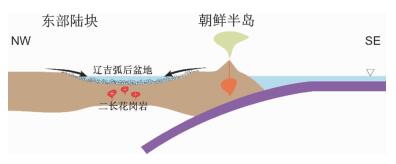
|
图 8 古元古代早期 (2.2~2.1Ga) 辽吉地区构造环境示意图 Fig. 8 Schematic illustration showing tectonic environment of the Liaoji region during Early Paleoproterozoic (2.2~2.1Ga) |
(1) 辽东古元古代条痕状花岗岩为高钾钙碱性铝质A型花岗岩,具有高的K2O/Na2O、FeOT/MgO、Ga/Al比值和Ga、Zr、Y含量以及低的CaO、MgO、Sr、Cr、Co、Ni含量,形成于低压条件下长英质地壳的部分熔融。
(2) 条痕状花岗岩富集Rb、U、K等大离子亲石元素和轻稀土元素,亏损Nb、Ta、Ti等高场强元素,具有明显的俯冲带岩浆特征。
(3) 古元古代早期 (2.2~2.1Ga) 辽吉地区处于大陆弧后盆地构造环境,强烈的弧后伸展作用产生了A2型条痕状花岗岩。在后期的地体拼贴过程中,条痕状花岗岩与周围岩石共同变形并最终构造挤压在一起。
致谢 主量和微量元素分析在国家地质实验测试中心完成; 同位素分析得到北京大学朱文萍老师和天津地质调查中心李国占老师的指导; 审稿专家提出了宝贵的意见;在此一并表示衷心的感谢。| [] | Bai J, Huang XG, Dai FY, Wu CH. 1993. Precambrian Crustal Evolution of China. Beijing: Geological Publishing House: 68-119. |
| [] | Bonin B. 2007. A-type granites and related rocks: Evolution of a concept, problems and prospects. Lithos, 97(1-2): 1–29. DOI:10.1016/j.lithos.2006.12.007 |
| [] | Briqueu L, Bougault H, Joron JL. 1984. Quantification of Nb, Ta, Ti and V anomalies in magmas associated with subduction zones: Petrogenetic implications. Earth and Planetary Science Letters, 68(2): 297–308. DOI:10.1016/0012-821X(84)90161-4 |
| [] | Bureau of Geology and Mineral Resources of Liaoning Province (BGMRL). 1989. Regional Geology of Liaoning Province. Beijing: Geological Publishing House: 7-324. |
| [] | Cai JH, Yan GH, Mu BL, Xu BL, Shao HX, Xu RH. 2002. U-Yb and Sm-Nd isotopic ages of an alkaline syenite complex body in Liangtun-Kuangdongguo, Gai County, Liaoning Province, China and their geological significance. Acta Petrologica Sinica, 18(3): 349–354. |
| [] | Chen RD. 1984. A Paleoproterozoic rift basin: Liaodong rift. Liaoning Geology, 1(2): 125–133. |
| [] | Chen SL, Huan YQ, Pei SJ. 2000. Rock lineage units of Proterozoic intrusive rocks in Liaoning Province. Liaoning Geology, 17(3): 206–212. |
| [] | Collins WJ, Beams SD, White AJR, Chappell BW. 1982. Nature and origin of A-type granites with particular reference to southeastern Australia. Contributions to Mineralogy and Petrology, 80(2): 189–200. DOI:10.1007/BF00374895 |
| [] | Condie KC. 1997. Tectonic settings. In: Condie KC (ed.). Plate Tectonics and Crustal Evolution. 4th Edition. Amsterdam: Elsevier, 69-109 |
| [] | Creaser RA, Price RC, Wormald RJ. 1991. A-type granites revisited: Assessment of a residual-source model. Geology, 19(2): 163–166. DOI:10.1130/0091-7613(1991)019<0163:ATGRAO>2.3.CO;2 |
| [] | Dall'Agnol R, Frost CD, Rämö OT. 2012. IGCP Project 510 "A-type Granites and Related Rocks through Time": Project vita, results, and contribution to granite research. Lithos, 151: 1–16. DOI:10.1016/j.lithos.2012.08.003 |
| [] | DePaolo DJ. 1981. Neodymium isotopes in the Colorado Front Range and crust-mantle evolution in the Proterozoic. Nature, 291(5812): 193–196. DOI:10.1038/291193a0 |
| [] | Eby GN. 1990. The A-type granitoids: A review of their occurrence and chemical characteristics and speculations on their petrogenesis. Lithos, 26(1-2): 115–134. DOI:10.1016/0024-4937(90)90043-Z |
| [] | Eby GN. 1992. Chemical subdivision of the A-type granitoids: Petrogenetic and tectonic implications. Geology, 20(7): 641–644. DOI:10.1130/0091-7613(1992)020<0641:CSOTAT>2.3.CO;2 |
| [] | Faure M, Lin W, Monié P, Bruguier O. 2004. Palaeoproterozoic arc magmatism and collision in Liaodong Peninsula (Northeast China). Terra Nova, 16(2): 75–80. DOI:10.1111/ter.2004.16.issue-2 |
| [] | Faure M, Trap P, Lin W, Monié P, Bruguier O. 2007. Polyorogenic evolution of the Paleoproterozoic Trans-North China Belt: New insights from the in Lüliangshan-Hengshan-Wutaishan and Fuping massifs. Episodes, 30(2): 95–106. |
| [] | Floyd PA, Winchester JA. 1975. Magma type and tectonic setting discrimination using immobile elements. Earth and Planetary Science Letters, 27(2): 211–218. DOI:10.1016/0012-821X(75)90031-X |
| [] | Frost BR, Barnes CG, Collins WJ, Arculus RJ, Ellis DJ, Frost CD. 2001. A geochemical classification for granitic rocks. Journal of Petrology, 42(11): 2033–2048. DOI:10.1093/petrology/42.11.2033 |
| [] | Frost CD, Rämö OT, Dall'Agnol R. 2007. IGCP Project 510: A-type granites and related rocks through time. Lithos, 97(1-2): 7–13. |
| [] | Grant ML, Wilde SA, Wu FY, Yang JH. 2009. The application of zircon cathodoluminescence imaging, Th-U-Pb chemistry and U-Pb ages in interpreting discrete magmatic and high-grade metamorphic events in the North China Craton at the Archean/Proterozoic boundary. Chemical Geology, 261(1-2): 155–171. DOI:10.1016/j.chemgeo.2008.11.002 |
| [] | Green TH. 1995. Significance of Nb/Ta as an indicator of geochemical processes in the crust-mantle system. Chemical Geology, 120(3-4): 347–359. DOI:10.1016/0009-2541(94)00145-X |
| [] | Guo BR, Liu SW, Zhang J, Yan M. 2015. Zircon U-Pb-Hf isotope systematics and geochemistry of Helong granite-greenstone belt in southern Jilin Province, China: Implications for Neoarchean crustal evolution of the northeastern margin of North China Craton. Precambrian Research, 271: 254–277. DOI:10.1016/j.precamres.2015.10.009 |
| [] | Hao DF, Li SZ, Zhao GC, Sun M, Han ZZ, Zhao GT. 2004. Origin and its constraint to tectonic evolution of Paleoproterozoic granitoids in the eastern Liaoning and Jilin provinces, North China. Acta Petrologica Sinica, 20(6): 1409–1416. |
| [] | Harris NBW, Pearce JA and Tindle AG. 1986. Geochemical characteristics of collision-zone magmatism. In: Coward MP and Ries AC (eds.). Collision Tectonics. Geological Society, London, Special Publications, 19(1): 67-81 |
| [] | He GP, Ye HW. 1998. Two types of Early Proterozoic metamorphism and its tectonic significance in eastern Liaoning and southern Jilin areas. Acta Petrologica Sinica, 14(2): 152–162. |
| [] | Hu GY, Fan CF, Li YH, Hou KJ, Liu Y, Wang TH. 2014. Zircon U-Pb dating of migmatitic granites of Ming'an Mg-borate deposit in Kuandian area, eastern Liaoning Province, and its constrains on mineralization age. Mineral Deposits, 33(2): 397–405. |
| [] | Hu GY, Li YH, Fan CF, Hou KJ, Zhao Y, Zeng LS. 2015. In situ LA-MC-ICP-MS boron isotope and zircon U-Pb age determinations of Paleoproterozoic borate deposits in Liaoning Province, northeastern China. Ore Geology Reviews, 65: 1127–1141. DOI:10.1016/j.oregeorev.2014.09.005 |
| [] | Jia XH, Wang Q, Tang GJ. 2009. A-type granites: Research progress and implications. Geotectonica et Metallogenia, 33(3): 465–480. |
| [] | King PL, White AJR, Chappell BW, Allen CM. 1997. Characterization and origin of aluminous A-type granites from the Lachlan Fold belt, southeastern Australia. Journal of Petrology, 38(3): 371–391. DOI:10.1093/petroj/38.3.371 |
| [] | Kröner A, Wilde SA, Li JH, Wang KY. 2005. Age and evolution of a Late Archean to Paleoproterozoic upper to lower crustal section in the Wutaishan/Hengshan/Fuping terrain of northern China. Journal of Asian Earth Sciences, 24(5): 577–595. DOI:10.1016/j.jseaes.2004.01.001 |
| [] | Kusky TM, Li JH, Tucker RD. 2001. The Archean Dongwanzi ophiolite complex, North China craton: 2.505-billion-year-old oceanic crust and mantle. Science, 292(5519): 1142–1145. DOI:10.1126/science.1059426 |
| [] | Kusky TM, Li JH. 2003. Paleoproterozoic tectonic evolution of the North China Craton. Journal of Asian Earth Sciences, 22(4): 383–397. DOI:10.1016/S1367-9120(03)00071-3 |
| [] | Kusky TM, Li JH, Santosh M. 2007a. The Paleoproterozoic North Hebei Orogen: North China craton's collisional suture with the Columbia supercontinent. Gondwana Research, 12(1-2): 4–28. DOI:10.1016/j.gr.2006.11.012 |
| [] | Kusky TM, Windley BF and Zhai MG. 2007b. Tectonic evolution of the North China Block: From orogen to craton to orogen. In: Zhai MG, Windley BF, Kusky T et al. (eds.). Mesozoic Sub-Continental Thinning Beneath Eastern North China. Geological Society, London, Special Publications, 280(1): 1-34 |
| [] | Kusky TM. 2011. Geophysical and geological tests of tectonic models of the North China Craton. Gondwana Research, 20(1): 26–35. DOI:10.1016/j.gr.2011.01.004 |
| [] | Lan TG, Fan HR, Yang KF, Cai YC, Wen BJ, Zhang W. 2015. Geochronology, mineralogy and geochemistry of alkali-feldspar granite and albite granite association from the Changyi area of Jiao-Liao-Ji Belt: Implications for Paleoproterozoic rifting of eastern North China Craton. Precambrian Research, 266: 86–107. DOI:10.1016/j.precamres.2015.04.021 |
| [] | Li SZ, Zhao GC, Sun M, Han ZZ, Luo Y, Hao DF, Xia XP. 2005. Deformation history of the Paleoproterozoic Liaohe assemblage in the eastern block of the North China Craton. Journal of Asian Earth Sciences, 24(5): 659–674. DOI:10.1016/j.jseaes.2003.11.008 |
| [] | Li SZ, Zhao GC, Sun M, Han ZZ, Zhao GT, Hao DF. 2006. Are the South and North Liaohe Groups of North China Craton different exotic terranes? Nd isotope constraints. Gondwana Research, 9(1-2): 198–208. DOI:10.1016/j.gr.2005.06.011 |
| [] | Li SZ, Zhao GC. 2007. SHRIMP U-Pb zircon geochronology of the Liaoji granitoids: Constraints on the evolution of the Paleoproterozoic Jiao-Liao-Ji belt in the Eastern Block of the North China Craton. Precambrian Research, 158(1-2): 1–16. DOI:10.1016/j.precamres.2007.04.001 |
| [] | Li SZ, Zhao GC, Wilde SA, Zhang J, Sun M, Zhang GW, Dai LM. 2010. Deformation history of the Hengshan-Wutai-Fuping Complexes: Implications for the evolution of the Trans-North China Orogen. Gondwana Research, 18(4): 611–631. DOI:10.1016/j.gr.2010.03.003 |
| [] | Li SZ, Zhao GC, Santosh M, Liu X, Dai LM. 2011. Palaeoproterozoic tectonothermal evolution and deep crustal processes in the Jiao-Liao-Ji Belt, North China Craton: A review. Geological Journal, 46(6): 525–543. DOI:10.1002/gj.1282 |
| [] | Li Z, Chen B. 2014. Geochronology and geochemistry of the Paleoproterozoic meta-basalts from the Jiao-Liao-Ji Belt, North China Craton: Implications for petrogenesis and tectonic setting. Precambrian Research, 255: 653–667. DOI:10.1016/j.precamres.2014.07.003 |
| [] | Li Z, Chen B, Wei CJ, Wang CX, Han W. 2015. Provenance and tectonic setting of the Paleoproterozoic metasedimentary rocks from the Liaohe Group, Jiao-Liao-Ji Belt, North China Craton: Insights from detrital zircon U-Pb geochronology, whole-rock Sm-Nd isotopes, and geochemistry. Journal of Asian Earth Sciences, 111: 711–732. DOI:10.1016/j.jseaes.2015.06.003 |
| [] | Li Z, Chen B, Liu JW, Zhang L, Yang C. 2015. Zircon U-Pb ages and their implications for the South Liaohe Group in the Liaodong Peninsula, Northeast China. Acta Petrologica Sinica, 31(6): 1589–1605. |
| [] | Liu DY, Nutman AP, Compston W, Wu JS, Shen QH. 1992. Remnants of≥3800Ma crust in the Chinese part of the Sino-Korean craton. Geology, 20(4): 339–342. DOI:10.1130/0091-7613(1992)020<0339:ROMCIT>2.3.CO;2 |
| [] | Liu FL, Liu PH, Wang F, Liu JH, Meng E, Cai J, Shi JR. 2014. U-Pb dating of zircons from granitic leucosomes in migmatites of the Jiaobei Terrane, southwestern Jiao-Liao-Ji Belt, North China Craton: Constraints on the timing and nature of partial melting. Precambrian Research, 245: 80–99. DOI:10.1016/j.precamres.2014.01.001 |
| [] | Liu FL, Liu PH, Wang F, Liu CH, Cai J. 2015. Progresses and overviews of voluminous meta-sedimentary series within the Paleoproterozoic Jiao-Liao-Ji orogenic/mobile belt, North China Craton. Acta Petrologica Sinica, 31(10): 2816–2846. |
| [] | Liu GQ. 1989. On origin of the bedded migmatite in eastern parts of Liaoning-Jilin provinces. Jilin Geology, 8(4): 42–49. |
| [] | Liu JH, Liu FL, Ding ZJ, Liu CH, Yang H, Liu PH, Wang F, Meng E. 2013a. The growth, reworking and metamorphism of early Precambrian crust in the Jiaobei terrane, the North China Craton: Constraints from U-Th-Pb and Lu-Hf isotopic systematics, and REE concentrations of zircon from Archean granitoid gneisses. Precambrian Research, 224: 287–303. DOI:10.1016/j.precamres.2012.10.003 |
| [] | Liu JL, Cui YC, Guan HM. 2002. Magmatic core complex in the Liaoning-Jilin-Korea Paleoproterozoic fold belt and its tectonic significance. Geological Bulletin of China, 21(4-5): 202–206. |
| [] | Liu PH, Liu FL, Yang H, Wang F, Liu JH. 2012. Protolith ages and timing of peak and retrograde metamorphism of the high-pressure granulites in the Shandong Peninsula, eastern North China Craton. Geoscience Frontiers, 3(6): 923–943. DOI:10.1016/j.gsf.2012.04.001 |
| [] | Liu PH, Liu FL, Liu CH, Wang F, Liu JH, Yang H, Cai J, Shi JR. 2013b. Petrogenesis, P-T-t path, and tectonic significance of high-pressure mafic granulites from the Jiaobei terrane, North China Craton. Precambrian Research, 233: 237–258. DOI:10.1016/j.precamres.2013.05.003 |
| [] | Liu SJ, Jahn BM, Wan YS, Xie HQ, Wang SJ, Xie SW, Dong CY, Ma MZ, Liu DY. 2015. Neoarchean to Paleoproterozoic high-pressure mafic granulite from the Jiaodong Terrain, North China Craton: Petrology, zircon age determination and geological implications. Gondwana Research, 28(2): 493–508. DOI:10.1016/j.gr.2014.07.006 |
| [] | Liu YD, Bing ZB, Dong JC. 1989. Features and significance of marine tholeiite of Early Proterozoic in Liaodong Peninsula. Liaoning Geology, 6(4): 289–297. |
| [] | Liu YJ, Li SZ. 1996. Palaeoproterozoic granite in Haicheng-Dashiqiao-Jidong area, eastern Liaoning. Liaoning Geology, 13(1): 10–18. |
| [] | Loiselle MC, Wones DR. 1979. Characteristics and origin of anorogenic granites. Geological of Society of America, 11(7): 468. |
| [] | Lu XP, Wu FY, Lin JQ, Sun DY, Zhang YB, Guo CL. 2004a. Geochronological successions of the early Precambrian granitic magmatism in southern Liaodong Peninsula and its constraints on tectonic evolution of the North China Craton. Chinese Journal of Geology, 39(1): 123–138. |
| [] | Lu XP, Wu FY, Zhang YB, Zhao CB, Guo CL. 2004b. Emplacement age and tectonic setting of the Paleoproterozoic Liaoji granites in Tonghua area, southern Jilin Province. Acta Petrologica Sinica, 20(3): 381–392. |
| [] | Lu XP, Wu FY, Guo JH, Yin CJ. 2005. Late Paleoproterozoic granitic magmatism and crustal evolution in the Tonghua region, Northeast China. Acta Petrologica Sinica, 21(3): 721–736. |
| [] | Lu XP, Wu FY, Guo JH, Wilde SA, Yang JH, Liu XM, Zhang XO. 2006. Zircon U-Pb geochronological constraints on the Paleoproterozoic crustal evolution of the Eastern block in the North China Craton. Precambrian Research, 146(3-4): 138–164. DOI:10.1016/j.precamres.2006.01.009 |
| [] | Luo Y, Sun M, Zhao GC, Li SZ, Xu P, Ye K, Xia XP. 2004. LA-ICP-MS U-Pb zircon ages of the Liaohe Group in the Eastern Block of the North China Craton: Constraints on the evolution of the Jiao-Liao-Ji Belt. Precambrian Research, 134(3-4): 349–371. DOI:10.1016/j.precamres.2004.07.002 |
| [] | Luo Y, Sun M, Zhao GC, Li SZ, Ayers JC, Xia XP, Zhang JH. 2008. A comparison of U-Pb and Hf isotopic compositions of detrital zircons from the North and South Liaohe groups: Constraints on the evolution of the Jiao-Liao-Ji Belt, North China Craton. Precambrian Research, 163(3-4): 279–306. DOI:10.1016/j.precamres.2008.01.002 |
| [] | Maniar PD, Piccoli PM. 1989. Tectonic discrimination of granitoids. The Geological Society of America Bulletin, 101(5): 635–643. DOI:10.1130/0016-7606(1989)101<0635:TDOG>2.3.CO;2 |
| [] | Meng E, Liu FL, Cui Y, Cai J. 2013a. Zircon U-Pb and Lu-Hf isotopic and whole-rock geochemical constraints on the protolith and tectonic history of the Changhai metamorphic supracrustal sequence in the Jiao-Liao-Ji Belt, southeast Liaoning Province, Northeast China. Precambrian Research, 233: 297–315. DOI:10.1016/j.precamres.2013.05.004 |
| [] | Meng E, Liu FL, Liu JH, Liu PH, Cui Y, Liu CH, Yang H, Wang F, Shi JR, Kong QB, Lian T. 2013b. Zircon U-Pb and Lu-Hf isotopic constraints on Archean crustal evolution in the Liaonan Complex of northeast China. Lithos, 177: 164–183. DOI:10.1016/j.lithos.2013.06.020 |
| [] | Meng E, Liu FL, Liu PH, Liu CH, Shi JR, Kong QB, Lian T. 2013. Depositional ages and tectonic implications for South Liaohe Group from Kuandian area in northeastern Liaodong Peninsula, Northeast China. Acta Petrologica Sinica, 29(7): 2465–2480. |
| [] | Meng E, Liu FL, Liu PH, Liu CH, Yang H, Wang F, Shi JR, Cai J. 2014. Petrogenesis and tectonic significance of Paleoproterozoic meta-mafic rocks from central Liaodong Peninsula, Northeast China: Evidence from zircon U-Pb dating and in situ Lu-Hf isotopes, and whole-rock geochemistry. Precambrian Research, 247: 92–109. DOI:10.1016/j.precamres.2014.03.017 |
| [] | Middlemost EAK. 1994. Naming materials in the magma/igneous rock system. Earth-Science Reviews, 37(3-4): 215–224. DOI:10.1016/0012-8252(94)90029-9 |
| [] | Patiño Douce AE. 1997. Generation of metaluminous A-type granites by low-pressure melting of calc-alkaline granitoids. Geology, 25(8): 743–746. DOI:10.1130/0091-7613(1997)025<0743:GOMATG>2.3.CO;2 |
| [] | Pearce JA. 1982. Trace element characteristics of lavas from destructive plate boundaries. In: Thorpe RS (ed.). Andesites. New York, USA: Wiley, 525-548 |
| [] | Pearce JA, Harris NBW, Tindle AG. 1984. Trace Element discrimination diagrams for the tectonic interpretation of granitic rocks. Journal of Petrology, 25(4): 956–983. DOI:10.1093/petrology/25.4.956 |
| [] | Peccerillo A, Taylor SR. 1976. Geochemistry of eocene calc-alkaline volcanic rocks from the Kastamonu area, Northern Turkey. Contributions to Mineralogy and Petrology, 58(1): 63–81. DOI:10.1007/BF00384745 |
| [] | Peng C, Xue LF, Zhu M, Chai Y, Liu WY. 2016. The location and evolution of the tectonic boundary between the Paleoproterozoic Jiao-Liao-Ji Belt and the Longgang Block, Northeast China. Precambrian Research, 272: 18–38. DOI:10.1016/j.precamres.2015.10.016 |
| [] | Peng P, Wang XP, Windley BF, Guo JH, Zhai MG, Li Y. 2014. Spatial distribution of ca.1950~1800Ma metamorphic events in the North China Craton: Implications for tectonic subdivision of the craton. Lithos, 202-203: 250–266. DOI:10.1016/j.lithos.2014.05.033 |
| [] | Qin Y, Chen DD, Liang YH, Zou CM, Zhang QW, Bai LA. 2014. Geochronology of Ji'an Group in Tonghua area, southern Jilin Province. Earth Science, 39(11): 1487–1499. |
| [] | Qu HX, Zhang Y, Lei GX, Wang ZJ, Cheng PQ, Zhang FS. 2000. On the Paleoproterozoic crust-mantle mixed complex in East Liaoning. Liaoning Geology, 17(3): 199–205. |
| [] | Santosh M. 2010. Assembling North China Craton within the Columbia supercontinent: The role of double-sided subduction. Precambrian Research, 178(1-4): 149–167. DOI:10.1016/j.precamres.2010.02.003 |
| [] | Santosh M, Liu SJ, Tsunogae T, Li JH. 2012. Paleoproterozoic ultrahigh-temperature granulites in the North China Craton: Implications for tectonic models on extreme crustal metamorphism. Precambrian Research, 222-223: 77–106. DOI:10.1016/j.precamres.2011.05.003 |
| [] | ŞengörAMC. 1990. Plate tectonics and orogenic research after 25 years: A Tethyan perspective. Earth-Science Reviews, 27(1-2): 1–201. |
| [] | Shan HX, Zhai MG, Oliveira EP, Santosh M, Wang F. 2015a. Convergent margin magmatism and crustal evolution during Archean-Proterozoic transition in the Jiaobei terrane: Zircon U-Pb ages, geochemistry, and Nd isotopes of amphibolites and associated grey gneisses in the Jiaodong complex, North China Craton. Precambrian Research, 264: 98–118. DOI:10.1016/j.precamres.2015.04.008 |
| [] | Shan HX, Zhai MG, Wang F, Zhou YY, Santosh M, Zhu XY, Zhang HF, Wang W. 2015b. Zircon U-Pb ages, geochemistry, and Nd-Hf isotopes of the TTG gneisses from the Jiaobei terrane: Implications for Neoarchean crustal evolution in the North China Craton. Journal of Asian Earth Sciences, 98: 61–74. DOI:10.1016/j.jseaes.2014.10.023 |
| [] | Song B, Nutman AP, Liu DY, Wu JS. 1996. 3800 to 2500Ma crustal evolution in the Anshan area of Liaoning Province, northeastern China. Precambrian Research, 78(1-3): 79–94. DOI:10.1016/0301-9268(95)00070-4 |
| [] | Sun M, Armstrong RL, Lambert RSJ, Jiang CC, Wu JH. 1993. Petrochemistry and Sr, Pb and Nd isotopic geochemistry of the Paleoproterozoic Kuandian complex, the eastern Liaoning Province, China. Precambrian Research, 62(1-2): 171–190. DOI:10.1016/0301-9268(93)90099-N |
| [] | Sun SS and McDonough WF. 1989. Chemical and isotopic systematics of oceanic basalts: Implications for mantle composition and processes. In: Saunders AD and Norry MJ (eds.). Magmatism in the Ocean Basins. Geological Society, London, Special Publications, 42(1): 313-345 |
| [] | Tam PY, Zhao GC, Liu FL, Zhou XW, Sun M, Li SZ. 2011. Timing of metamorphism in the Paleoproterozoic Jiao-Liao-Ji Belt: New SHRIMP U-Pb zircon dating of granulites, gneisses and marbles of the Jiaobei massif in the North China Craton. Gondwana Research, 19(1): 150–162. DOI:10.1016/j.gr.2010.05.007 |
| [] | Tam PY, Zhao GC, Sun M, Li SZ, Iizuka Y, Ma GSK, Yin CQ, He YH, Wu ML. 2012a. Metamorphic P-T path and tectonic implications of medium-pressure pelitic granulites from the Jiaobei massif in the Jiao-Liao-Ji Belt, North China Craton. Precambrian Research, 220-221: 177–191. DOI:10.1016/j.precamres.2012.08.008 |
| [] | Tam PY, Zhao GC, Sun M, Li SZ, Wu ML, Yin CQ. 2012b. Petrology and metamorphic P-T path of high-pressure mafic granulites from the Jiaobei massif in the Jiao-Liao-Ji Belt, North China Craton. Lithos, 155: 94–109. DOI:10.1016/j.lithos.2012.08.018 |
| [] | Tam PY, Zhao GC, Zhou XW, Sun M, Guo JH, Li SZ, Yin CQ, Wu ML, He YH. 2012c. Metamorphic P-T path and implications of high-pressure pelitic granulites from the Jiaobei massif in the Jiao-Liao-Ji Belt, North China Craton. Gondwana Research, 22(1): 104–117. DOI:10.1016/j.gr.2011.09.006 |
| [] | Tang J, Zheng YF, Wu YB, Gong B, Liu XM. 2007. Geochronology and geochemistry of metamorphic rocks in the Jiaobei terrane: Constraints on its tectonic affinity in the Sulu orogen. Precambrian Research, 152(1-2): 48–82. DOI:10.1016/j.precamres.2006.09.001 |
| [] | Trap P, Faure M, Lin W, Le Breton N, Monié P. 2012. Paleoproterozoic tectonic evolution of the Trans-North China Orogen: Toward a comprehensive model. Precambrian Research, 222-223: 191–211. DOI:10.1016/j.precamres.2011.09.008 |
| [] | Wan YS, Liu DY, Song B, Wu JS, Yang CH, Zhang ZQ, Geng YS. 2005. Geochemical and Nd isotopic compositions of 3.8Ga meta-quartz dioritic and trondhjemitic rocks from the Anshan area and their geological significance. Journal of Asian Earth Sciences, 24(5): 563–575. DOI:10.1016/j.jseaes.2004.02.009 |
| [] | Wan YS, Song B, Liu DY, Wilde SA, Wu JS, Shi YR, Yin XY, Zhou HY. 2006. SHRIMP U-Pb zircon geochronology of Palaeoproterozoic metasedimentary rocks in the North China Craton: Evidence for a major Late Palaeoproterozoic tectonothermal event. Precambrian Research, 149(3-4): 249–271. DOI:10.1016/j.precamres.2006.06.006 |
| [] | Wan YS, Liu DY, Nutman A, Zhou HY, Dong CY, Yin XY, Ma MZ. 2012. Multiple 3.8~3.1Ga tectono-magmatic events in a newly discovered area of ancient rocks (the Shengousi Complex), Anshan, North China Craton. Journal of Asian Earth Sciences, 54-55(0): 18–30. |
| [] | Wan YS, Xie SW, Yang CH, Kröner A, Ma MZ, Dong CY, Du LL, Xie HQ, Liu DY. 2014. Early Neoarchean (~2.7Ga) tectono-thermal events in the North China Craton: A synthesis. Precambrian Research, 247(0): 45–63. |
| [] | Wang HC, Lu SN, Chu H, Xiang ZQ, Zhang CJ, Liu H. 2011. Zircon U-Pb age and tectonic setting of meta-basalts of Liaohe Group in Helan area, Liaoyang, Liaoning Province. Journal of Jilin University (Earth Science Edition), 41(5): 1322–1334. |
| [] | Wang HC, Ren YW, Lu SN, Kang JL, Chu H, Yu HB, Zhang CJ. 2015. Stratigraphic units and tectonic setting of the Paleoproterozoic Liao-Ji orogen. Acta Geoscientica Sinica, 36(5): 583–598. |
| [] | Wang W, Zhai MG, Li TS, Santosh M, Zhao L, Wang HZ. 2014. Archean-Paleoproterozoic crustal evolution in the eastern North China Craton: Zircon U-Th-Pb and Lu-Hf evidence from the Jiaobei terrane. Precambrian Research, 241: 146–160. DOI:10.1016/j.precamres.2013.11.011 |
| [] | Wang ZH. 2009. Tectonic evolution of the Hengshan-Wutai-Fuping complexes and its implication for the Trans-North China Orogen. Precambrian Research, 170(1-2): 73–87. DOI:10.1016/j.precamres.2008.11.003 |
| [] | Whalen JB, Currie KL, Chappell BW. 1987. A-type granites: Geochemical characteristics, discrimination and petrogenesis. Contributions to Mineralogy and Petrology, 95(4): 407–419. DOI:10.1007/BF00402202 |
| [] | Wu FY, Yang JH, Wilde SA, Zhang XO. 2005. Geochronology, petrogenesis and tectonic implications of Jurassic granites in the Liaodong Peninsula, NE China. Chemical Geology, 221(1-2): 127–156. DOI:10.1016/j.chemgeo.2005.04.010 |
| [] | Wu FY, Zhang YB, Yang JH, Xie LW, Yang YH. 2008. Zircon U-Pb and Hf isotopic constraints on the Early Archean crustal evolution in Anshan of the North China Craton. Precambrian Research, 167(3-4): 339–362. DOI:10.1016/j.precamres.2008.10.002 |
| [] | Wu ML, Zhao GC, Sun M, Bao ZA, Tam PY, He YH. 2014a. Tectonic affinity and reworking of the Archaean Jiaodong Terrane in the Eastern Block of the North China Craton: Evidence from LA-ICP-MS U-Pb zircon ages. Geological Magazine, 151(2): 365–371. DOI:10.1017/S0016756813000721 |
| [] | Wu ML, Zhao GC, Sun M, Li SZ, Bao ZA, Tam PY, Eizenhöefer PR, He YH. 2014b. Zircon U-Pb geochronology and Hf isotopes of major lithologies from the Jiaodong Terrane: Implications for the crustal evolution of the Eastern Block of the North China Craton. Lithos, 190-191: 71–84. DOI:10.1016/j.lithos.2013.12.004 |
| [] | Wu ML, Lin SF, Wan YS, Gao JF. 2016. Crustal evolution of the Eastern Block in the North China Craton: Constraints from zircon U-Pb geochronology and Lu-Hf isotopes of the Northern Liaoning Complex. Precambrian Research, 275: 35–47. DOI:10.1016/j.precamres.2015.12.013 |
| [] | Xie LW, Yang JH, Wu FY, Yang YH, Wilde SA. 2011. PbSL dating of garnet and staurolite: Constraints on the Paleoproterozoic crustal evolution of the Eastern Block, North China Craton. Journal of Asian Earth Sciences, 42(1-2): 142–154. DOI:10.1016/j.jseaes.2011.04.016 |
| [] | Xie SW, Xie HQ, Wang SJ, Kröner A, Liu SJ, Zhou HY, Ma MZ, Dong CY, Liu DY, Wan YS. 2014. Ca. 2.9Ga granitoid magmatism in eastern Shandong, North China Craton: Zircon dating, Hf-in-zircon isotopic analysis and whole-rock geochemistry. Precambrian Research, 255: 538–562. DOI:10.1016/j.precamres.2014.09.006 |
| [] | Yang JH, Wu FY, Xie LW, Liu XM. 2007. Petrogenesis and tectonic implications of Kuangdonggou syenites in the Liaodong Peninsula, East North China Craton: Constraints from in-situ zircon U-Pb ages and Hf isotopes. Acta Petrologica Sinica, 23(2): 263–276. |
| [] | Yang MC, Chen B, Yan C. 2015a. Petrogenesis of Paleoproterozoic gneissic granites from Jiao-Liao-Ji Belt of North China Craton and their tectonic implications. Journal of Earth Sciences and Environment, 37(5): 31–51. |
| [] | Yang MC, Chen B, Yan C. 2015b. Petrological, geochronological, geochemical and Sr-Nd-Hf isotopic constraints on the petrogenesis of the Shuangcha Paleoproterozoic megaporphyritic granite in the southern Jilin Province: Tectonic implications. Acta Petrologica Sinica, 31(6): 1573–1588. |
| [] | Yu JJ, Yang DB, Feng H, Lan X. 2007. Chronology of amphibolite protolith in Haicheng of southern Liaoning: Evidence from LA-ICP-MS zircon U-Pb dating. Global Geology, 26(4): 391–396. |
| [] | Yuan LL, Zhang XH, Xue FH, Han CM, Chen HH, Zhai MG. 2015. Two episodes of Paleoproterozoic mafic intrusions from Liaoning Province, North China Craton: Petrogenesis and tectonic implications. Precambrian Research, 264: 119–139. DOI:10.1016/j.precamres.2015.04.017 |
| [] | Zhai MG, Zhao GC, Zhang Q, Kusky TM, Li JH. 2002. Is the Dongwanzi complex an Archean ophiolite?. Science, 195(5557): 923. |
| [] | Zhai MG, Santosh M. 2011. The Early Precambrian odyssey of the North China Craton: A synoptic overview. Gondwana Research, 20(1): 6–25. DOI:10.1016/j.gr.2011.02.005 |
| [] | Zhang J, Zhao GC, Li SZ, Sun M, Chan LS, Shen WL, Liu SW. 2012. Structural pattern of the Wutai Complex and its constraints on the tectonic framework of the Trans-North China Orogen. Precambrian Research, 222-223: 212–229. DOI:10.1016/j.precamres.2011.08.009 |
| [] | Zhang QS. 1984. Geology and Metallogeny of the Early Precambrian in China. Changchun: Jilin People's Publishing House: 33-81. |
| [] | Zhang QS, Li SY. 1985. The Liaojitite suite: A special eugeosyncline facies of the Early Proterozoic. Journal of Changchun College of Geology(1): 1–12. |
| [] | Zhang QS. 1988. Early Crust and Mineral Deposits of Liaodong Peninsula. Beijing: Geological Publishing House: 276-331. |
| [] | Zhao FS, Hu P. 1989. Features and origin of streaky granitic-rocks from Hupiyu. Liaoning Geology, 6(4): 298–311. |
| [] | Zhao GC, Wilde SA, Cawood PA, Sun M. 2001. Archean blocks and their boundaries in the North China Craton: Lithological, geochemical, structural and P-T path constraints and tectonic evolution. Precambrian Research, 107(1-2): 45–73. DOI:10.1016/S0301-9268(00)00154-6 |
| [] | Zhao GC, Sun M, Wilde SA, Li SZ. 2005. Late Archean to Paleoproterozoic evolution of the North China Craton: Key issues revisited. Precambrian Research, 136(2): 177–202. DOI:10.1016/j.precamres.2004.10.002 |
| [] | Zhao GC, Cao L, Wilde SA, Sun M, Choe WJ, Li SZ. 2006. Implications based on the first SHRIMP U-Pb zircon dating on Precambrian granitoid rocks in North Korea. Earth and Planetary Science Letters, 251(3-4): 365–379. DOI:10.1016/j.epsl.2006.09.021 |
| [] | Zhao GC, Cawood PA. 2012. Precambrian geology of China. Precambrian Research, 222-223: 13–54. DOI:10.1016/j.precamres.2012.09.017 |
| [] | Zhao GC, Guo JH. 2012. Precambrian geology of China: Preface. Precambrian Research, 222-223: 1–12. DOI:10.1016/j.precamres.2012.09.018 |
| [] | Zhao GC, Cawood PA, Li SZ, Wilde SA, Sun M, Zhang J, He YH, Yin CQ. 2012. Amalgamation of the North China Craton: Key issues and discussion. Precambrian Research, 222-223: 55–76. DOI:10.1016/j.precamres.2012.09.016 |
| [] | Zhao GC, Zhai MG. 2013. Lithotectonic elements of Precambrian basement in the North China Craton: Review and tectonic implications. Gondwana Research, 23(4): 1207–1240. DOI:10.1016/j.gr.2012.08.016 |
| [] | Zhao L, Li TS, Peng P, Guo JH, Wang W, Wang HZ, Santosh M, Zhai MG. 2015. Anatomy of zircon growth in high pressure granulites: SIMS U-Pb geochronology and Lu-Hf isotopes from the Jiaobei Terrane, eastern North China Craton. Gondwana Research, 28(4): 1373–1390. DOI:10.1016/j.gr.2014.10.009 |
| [] | Zheng YF, Xiao WJ, Zhao GC. 2013. Introduction to tectonics of China. Gondwana Research, 23(4): 1189–1206. DOI:10.1016/j.gr.2012.10.001 |
| [] | Zhou JB, Wilde SA, Zhao GC, Zheng CQ, Jin W, Zhang XZ, Cheng H. 2008a. SHRIMP U-Pb zircon dating of the Neoproterozoic Penglai Group and Archean gneisses from the Jiaobei Terrane, North China, and their tectonic implications. Precambrian Research, 160(3-4): 323–340. DOI:10.1016/j.precamres.2007.08.004 |
| [] | Zhou XW, Wei CJ, Geng YS, Zhang LF. 2004. Discovery and implications of the high-pressure pelitic granulite from the Jiaobei massif. Chinese Science Bulletin, 49(18): 1942–1948. DOI:10.1007/BF03184286 |
| [] | Zhou XW, Zhao GC, Wei CJ, Geng YS, Sun M. 2008b. EPMA U-Th-Pb monazite and SHRIMP U-Pb zircon geochronology of high-pressure pelitic granulites in the Jiaobei massif of the North China Craton. American Journal of Science, 308(3): 328–350. DOI:10.2475/03.2008.06 |
| [] | Zhu MT, Zhang LC, Dai YP, Wang CL. 2015. In situ zircon U-Pb dating and O isotopes of the Neoarchean Hongtoushan VMS Cu-Zn deposit in the North China Craton: Implication for the ore genesis. Ore Geology Reviews, 67: 354–367. DOI:10.1016/j.oregeorev.2014.12.019 |
| [] | 白瑾, 黄学光, 戴凤岩, 吴昌华. 1993. 中国前寒武纪地壳演化. 北京: 地质出版社: 68-119. |
| [] | 蔡剑辉, 阎国翰, 牟保磊, 许保良, 邵宏翔, 许荣华. 2002. 辽宁盖县梁屯-矿洞沟碱性正长岩杂岩体的U-Pb和Sm-Nd年龄及其地质意义. 岩石学报, 18(3): 349–354. |
| [] | 陈荣度. 1984. 一个早元古代裂谷盆地——辽东裂谷. 辽宁地质, 1(2): 125–133. |
| [] | 陈树良, 郇彦清, 裴世俊. 2000. 辽宁元古宙侵入岩岩石谱系单位. 辽宁地质, 17(3): 206–212. |
| [] | 郝德峰, 李三忠, 赵国春, 孙敏, 韩宗珠, 赵广涛. 2004. 辽吉地区古元古代花岗岩成因及对构造演化的制约. 岩石学报, 20(6): 1409–1416. |
| [] | 贺高品, 叶慧文. 1998. 辽东-吉南地区早元古代两种类型变质作用及其构造意义. 岩石学报, 14(2): 152–162. |
| [] | 胡古月, 范昌福, 李延河, 侯可军, 刘燚, 王天慧. 2014. 辽东明安硼镁矿床混合花岗岩的锆石U-Pb年龄及对成矿时代的制约. 矿床地质, 33(2): 397–405. |
| [] | 贾小辉, 王强, 唐功建. 2009. A型花岗岩的研究进展及意义. 大地构造与成矿学, 33(3): 465–480. |
| [] | 李壮, 陈斌, 刘经纬, 张璐, 杨川. 2015. 辽东半岛南辽河群锆石U-Pb年代学及其地质意义. 岩石学报, 31(6): 1589–1605. |
| [] | 辽宁省地质矿产局. 1989. 辽宁省区域地质志. 北京: 地质出版社: 7-324. |
| [] | 刘福来, 刘平华, 王舫, 刘超辉, 蔡佳. 2015. 胶-辽-吉古元古代造山/活动带巨量变沉积岩系的研究进展. 岩石学报, 31(10): 2816–2846. |
| [] | 刘光启. 1989. 辽吉东部层状混合岩的成因. 吉林地质, 8(4): 42–49. |
| [] | 刘俊来, 崔迎春, 关会梅. 2002. 辽吉朝褶皱带古元古宙岩浆核杂岩及其大地构造意义. 地质通报, 21(4-5): 202–206. |
| [] | 刘永达, 邴志波, 董景超. 1989. 辽东半岛早元古宙海相拉斑玄武岩特征及其意义. 辽宁地质, 6(4): 289–297. |
| [] | 刘永江, 李三忠. 1996. 辽宁海城-大石桥-吉洞地区早元古代花岗岩. 辽宁地质, 13(1): 10–18. |
| [] | 路孝平, 吴福元, 林景仟, 孙德有, 张艳斌, 郭春丽. 2004a. 辽东半岛南部早前寒武纪花岗质岩浆作用的年代学格架. 地质科学, 39(1): 123–138. |
| [] | 路孝平, 吴福元, 张艳斌, 赵成弼, 郭春丽. 2004b. 吉林南部通化地区古元古代辽吉花岗岩的侵位年代与形成构造背景. 岩石学报, 20(3): 381–392. |
| [] | 路孝平, 吴福元, 郭敬辉, 殷长建. 2005. 通化地区古元古代晚期花岗质岩浆作用与地壳演化. 岩石学报, 21(3): 721–736. |
| [] | 孟恩, 刘福来, 刘平华, 刘超辉, 施建荣, 孔庆波, 廉涛. 2013. 辽东半岛东北部宽甸地区南辽河群沉积时限的确定及其构造意义. 岩石学报, 29(7): 2465–2480. |
| [] | 秦亚, 陈丹丹, 梁一鸿, 邹存铭, 张青伟, 白令安. 2014. 吉林南部通化地区集安群的年代学. 地球科学, 39(11): 1487–1499. |
| [] | 曲洪祥, 张永, 雷广新, 王志军, 程培起, 张福生. 2000. 试论辽东地区古元古代壳幔混合杂岩. 辽宁地质, 17(3): 199–205. |
| [] | 王惠初, 陆松年, 初航, 相振群, 张长捷, 刘欢. 2011. 辽阳河栏地区辽河群中变质基性熔岩的锆石U-Pb年龄与形成构造背景. 吉林大学学报 (地球科学版), 41(5): 1322–1334. |
| [] | 王惠初, 任云伟, 陆松年, 康健丽, 初航, 于宏斌, 张长捷. 2015. 辽吉古元古代造山带的地层单元划分与构造属性. 地球学报, 36(5): 583–598. |
| [] | 杨进辉, 吴福元, 谢烈文, 柳小明. 2007. 辽东矿洞沟正长岩成因及其构造意义:锆石原位微区U-Pb年龄和Hf同位素制约. 岩石学报, 23(2): 263–276. |
| [] | 杨明春, 陈斌, 闫聪. 2015a. 华北克拉通胶-辽-吉带古元古代条痕状花岗岩成因及其构造意义. 地球科学与环境学报, 37(5): 31–51. |
| [] | 杨明春, 陈斌, 闫聪. 2015b. 吉南地区古元古代双岔巨斑状花岗岩成因及其构造意义:岩石学、年代学、地球化学和Sr-Nd-Hf同位素证据. 岩石学报, 31(6): 1573–1588. |
| [] | 于介江, 杨德彬, 冯虹, 兰翔. 2007. 辽南海城斜长角闪岩原岩的形成时代:锆石LA-ICP-MS U-Pb定年证据. 世界地质, 26(4): 391–396. |
| [] | 张秋生. 1984. 中国早前寒武纪地质及成矿作用. 长春: 吉林人民出版社: 33-81. |
| [] | 张秋生, 李守义. 1985. 辽吉岩套——早元古宙的一种特殊优地槽相杂岩. 长春地质学院学报(1): 1–12. |
| [] | 张秋生. 1988. 辽东半岛早期地壳与矿床. 北京: 地质出版社: 276-331. |
| [] | 赵凤顺, 胡平. 1989. 虎皮峪条痕状花岗质岩石特征及成因探讨. 辽宁地质, 6(4): 298–311. |
 2017, Vol. 33
2017, Vol. 33

